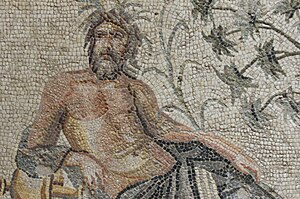Awater deity is a deityinmythology associated with water or various bodies of water. Water deities are common in mythology and were usually more important among civilizations in which the sea or ocean, or a great river was more important. Another important focus of worship of water deities has been springs or holy wells.

As a form of animal worship, whales and snakes (hence dragons) have been regarded as godly deities throughout the world (as are other animals such as turtles, fish, crabs, and sharks). In Asian lore, whales and dragons sometimes have connections.[1] Serpents are also common as a symboloras serpentine deities, sharing many similarities with dragons.
In Hindu culture, each water body is worshipped as a form of God. Hence, the rivers are worshipped as goddesses and the ocean is worshipped as a god.
Cambodia
• Yeay Mao, a neak ta divinity in Khmer Buddhism that is the patron guardian of sailors, travelers, and hunters.
Finnish
Lencan